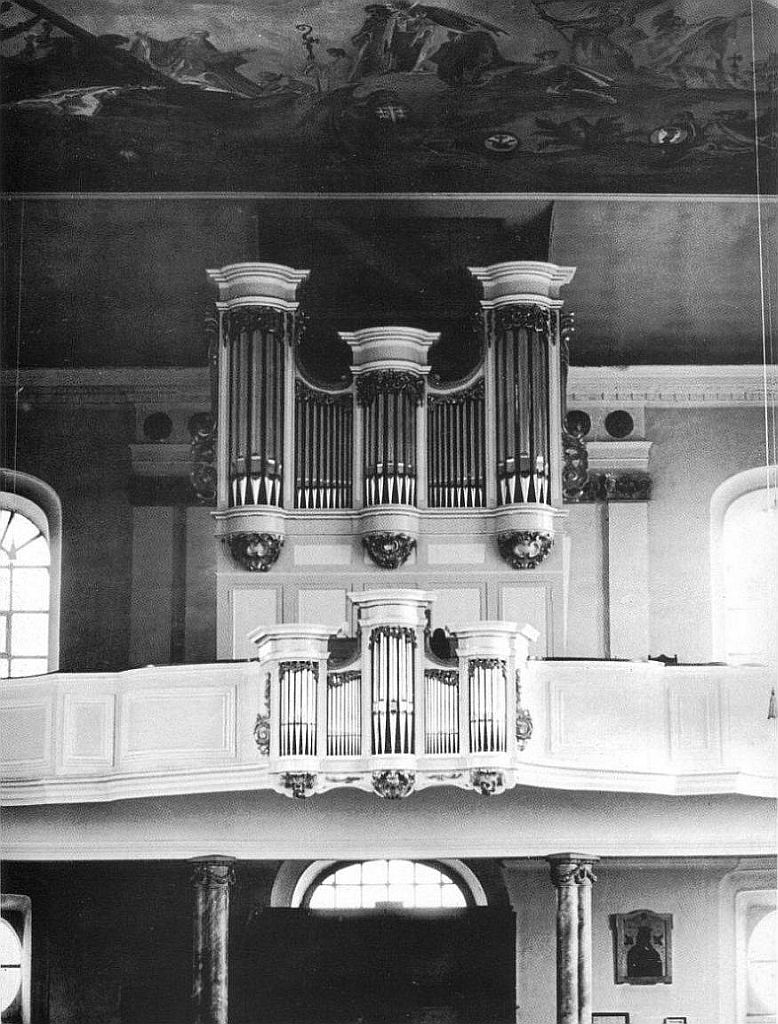Complete description of the selected organ

Source: firma Hugo Mayer
Blieskastel, Deutschland (Saarland) - Schlosskirche (Katholische Pfarrkirche Sankt Anna und Philipp)
Municipal: Blieskastel
Address: Schloßbergstraße 47, 66440, Blieskastel
Website: https://www.hl-franziskus-blieskastel.de/
Description nr.: 2014201.
Built by: Hugo Mayer Orgelbau (1972)
The organ contains older material: Organ case from 1905 by G.F. Steinmeyer und Co.
Technical data
Specification
Hauptwerk (C-g'''): Bourdon 16' - 2018; C-f' from Subbass, Praestant 8' - 2018, Rohrflöte 8', Quintade 8', Octave 4' - 2018, Kleingedackt 4', Principalquinte 2 2/3', Superoctave 2', Mixtur 4 fach (1 1/3'), Trompete 8' - 2018.
Rückpositiv (C-g'''): Holzgedackt 8', Praestant 4' - 2018, Principal 2', Larigot 2' + 1 1/3'' - 2018, Sesquialter 2 fach (1 1/3') - 2018, Vox Humana 8' - 2018, Tremulant.
Schwellwerk (C-g'''): Holzflöte 8', Salicional 8' - 2018, Schwebung 8' (from c°) - 2018, Fugara 4' - 2018, Querflöte 4', Nazard 2 2/3', Waldflöte 2', Terz 1 3/5', Trompette Harmonique 8', Hautbois 8', Tremulant.
Pedal (C-f'): Untersatz 32' - 2018; acoustic extension, Subbass 16', Octavbass 8', Metallgedackt 8' - extension, Octave 4' - extension, Posaune 16' - 2018, Trompete 8' - extension.
Couplers: Hauptwerk - Rückpositiv, Hauptwerk - Schwellwerk, Rückpositiv - Schwellwerk, Pedal - Hauptwerk, Pedal - Rückpositiv, Pedal - Schwellwerk.
Accessories: Sezterkombinationen 2', Rollschweller 2'.

Source: firma Hugo Mayer
Blieskastel, Deutschland (Saarland) - Schlosskirche (Katholische Pfarrkirche Sankt Anna und Philipp)
Municipal: Blieskastel
Address: Schloßbergstraße 47, 66440, Blieskastel
Website: https://www.hl-franziskus-blieskastel.de/
Description nr.: 2014201.
Built by: Hugo Mayer Orgelbau (1972)
The organ contains older material: Organ case from 1905 by G.F. Steinmeyer und Co.
| Year | Builder | Opus | Activity | 1905 | G.F. Steinmeyer und Co. | 851 | new organ | 1972 | Hugo Mayer Orgelbau | new organ in old case | 2018 | Klais Orgelbau | rebuild |
- The Steinmeyer company built a new organ as opus 851 for the Schlosskirche in Blieskastel in 1905. They designed an organ case in a classical baroque style. A positive was also built, but this remained empty, with non speaking prospect pipes. The Steinmeyer organ had 24 stops, two manuals and pedal and was built with pneumatic action and membrane chests.
- The interior was replaced by a new instrument in 1972 by Hugo Mayer. At this time the positive was also taken into function.
- Because of many technical problems that occured, the organ was rebuilt by Klais in 2018. They constructed a new console, a complete new action, partial new wind chests and new prosptect pipes. The stop list was slighty modified and the internal structure of the instrument was corrected. The renewed organ was dedicated on October 28, 2018. It was played by that occasion by Christian von Blohn and Matthias Leiner.
Technical data
| Number of stops per division | |
| - Hauptwerk | 10 |
| - Rückpositiv | 6 |
| - Schwellwerk | 10 |
| - Pedal | 7 (3) |
| Total number of stops | 33 |
| Key action | Mechanical |
| Stop action | Electrical |
| Windchest(s) | Slider chests |
Specification
Hauptwerk (C-g'''): Bourdon 16' - 2018; C-f' from Subbass, Praestant 8' - 2018, Rohrflöte 8', Quintade 8', Octave 4' - 2018, Kleingedackt 4', Principalquinte 2 2/3', Superoctave 2', Mixtur 4 fach (1 1/3'), Trompete 8' - 2018.
Rückpositiv (C-g'''): Holzgedackt 8', Praestant 4' - 2018, Principal 2', Larigot 2' + 1 1/3'' - 2018, Sesquialter 2 fach (1 1/3') - 2018, Vox Humana 8' - 2018, Tremulant.
Schwellwerk (C-g'''): Holzflöte 8', Salicional 8' - 2018, Schwebung 8' (from c°) - 2018, Fugara 4' - 2018, Querflöte 4', Nazard 2 2/3', Waldflöte 2', Terz 1 3/5', Trompette Harmonique 8', Hautbois 8', Tremulant.
Pedal (C-f'): Untersatz 32' - 2018; acoustic extension, Subbass 16', Octavbass 8', Metallgedackt 8' - extension, Octave 4' - extension, Posaune 16' - 2018, Trompete 8' - extension.
Couplers: Hauptwerk - Rückpositiv, Hauptwerk - Schwellwerk, Rückpositiv - Schwellwerk, Pedal - Hauptwerk, Pedal - Rückpositiv, Pedal - Schwellwerk.
Accessories: Sezterkombinationen 2', Rollschweller 2'.
| Compound stop | Composition |
| Sesquialter 2 fach (Rückpositiv) | C: 1 1/3' - 4/5'. c°: 2 2/3' - 1 3/5'. |
| Other specifications | |
|---|---|
| Different specifications |
|
| Literature |
|
| Links |
https://de.wikipedia.org/wiki/Schlosskirche_(Blieskastel)#Orgel |
